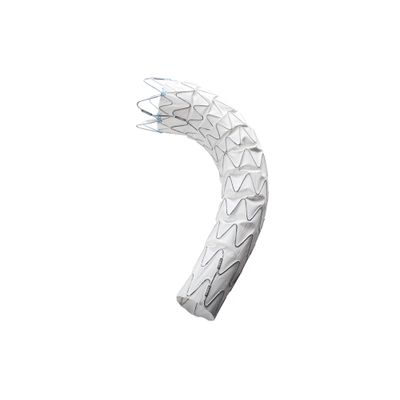

- Home
- Companies
- Lifetech Scientific (Shenzhen) Co., ...
- Products
- Ankura - TAA Stent Graft Product ...

Ankura - TAA Stent Graft Product Specification
The Ankura™ Thoracic Stent Graft is specifically designed for endovascular treatment of thoracic aortic dissection, aneurysm and other relative diseases. It reinforces the vascular wall of thoracic aorta from rupture.
Optimal Proximal Bare Stent
- Allow for deployment across the LSA or LCCA without occluding the blood flow
- Provide extended Proximal Landing Zone
- Less traumatic to the aortic branches
Proximal Sealing and Fixation
- MINI Wave - Enhanced apposition to the aortic wall
- Decreased endoleak risk
- Migration resistant
Greater Flexibility
- Conform to the natural curvature of thoracic aorta
- Reduce the possibility of kinking
- 4mm, 6mm and 8mm taper available
Other Strengths
- Self-expanding Nitinol stent – Radial force fixation
- No suture on the main body – Avoid pinhole leakage ( Type ? endoleak)
- Longitudinal supporting strut on the greater curvature – Avoid stent shortening, provide axial support
- e-PTFE Dual Membrane – Excellent biocompatibility and durability
- Kink-resistant delivery system with Hydrophilic Coating
Magnetic Resonance Imaging (MRI)
A patient after being implanted with the Ankura Stent Graft can be safe to have MRI procedure under the following conditions:
- Static magnetic field of 3.0 Tesla or less
- Spatial gradient filed of ≤720Gauss/cm
- Maximum whole-body-averaged specific absorption rate (SAR) of 2W/kg for 15 minutes of scanning
Note: MRI information is provided on your Implant Card for the implanted device. Show this card to your healthcare providers before MRI procedure.
Expected lifetime of Ankura Device
The Ankura Stent Graft is a permanently implanted device. Under normal circumstances, it will stay in the patient`s body for life, unless it is required to be removed by the physician’s professional judgment.
Follow up
It is important to schedule regular follow-up visits with your doctor. Follow-up visit will help the doctor to check your aneurysm/dissection and stent graft on a regular basis. The follow up visit should be performed at 24 hours, 1, 3, 6, 12 and 24 months after the procedure, and can be adjusted by the doctor depending on your condition.
At each visit, imaging such as CT scans will be carried out to determine the performance of the stent graft. If you have poor kidney function, you should ask your doctor about the dyes used in some of these imaging studies, as they may be harmful.
Material/Substances in Contact with Patient
The AnkuraTM Stent Graf implants are composed of: Nitinol, Stainless steel, Platinum-Iridium, Polytetrafluoroethylene (PTFE) and Polypropylene (PP), which are non-absorbable. The products belong to the group of endovascular implants. During the intended use, the thoracic aorta, abdominal aorta, iliac artery, femoral artery as well the blood will come in contact with the device.
Note: If you have a history of metal allergies, you should ask your doctor. Your doctor will help you decide whether it is appropriate for you to get an Ankura stent graft.
